dshanpnw
fully equipped rock polisher
  
Member since December 2020
Posts: 1,158
|
Post by dshanpnw on Nov 11, 2023 10:16:58 GMT -5
Nice job! The second one looks like A version of Morgan Hill I’m sure of it… It sure does, I'm going to go with it. Thanks |
|
dshanpnw
fully equipped rock polisher
  
Member since December 2020
Posts: 1,158
|
Post by dshanpnw on Nov 11, 2023 10:23:10 GMT -5
Very nice cabs! I have to ask why you used optical quartz on the back of the Bruneau? Seems like kind of a waste since it's the back and Bruneau is opaque. I was going to ask the same question! I'm curious too. Usually optical quartz is used on the front side of a cab...maybe something that isn't stable. I can't remember exactly who (I think it was Bill)...but someone did a Dino Bone cab with the quartz on the front so the bone itself didn't have to be ground down at all. I really like every one of these cabs though!  Frack, never again.  I appreciate it Jason. Super glad I posted it as a sharp learning point. |
|
dshanpnw
fully equipped rock polisher
  
Member since December 2020
Posts: 1,158
|
Post by dshanpnw on Nov 11, 2023 10:25:47 GMT -5
Very nice cabs! I have to ask why you used optical quartz on the back of the Bruneau? Seems like kind of a waste since it's the back and Bruneau is opaque. What if I dome the back, the quartz, would that make it more of an attractive pendant piece? |
|
dshanpnw
fully equipped rock polisher
  
Member since December 2020
Posts: 1,158
|
Post by dshanpnw on Nov 11, 2023 10:39:03 GMT -5
I believe the story was told in Rock and Gem magazine. Some prospectors/miners were up there and to their surprise they found a dead camel. A little out of place and unusual, so they coined the name. That's the story I heard and read;
Dead Camel Mountains. A very similar story related to these same US Army camels can be found associated with these mountains found in Nevada. From a rock hounding site, RareRocksAndGems.com:
In 1855, under the direction of then-Secretary of War Jefferson Davis, Congress appropriated $30,000 for "the purchase and importation of camels and dromedaries to be employed for military purposes." Davis believed that camels were key to the country's expansion westward; a transcontinental railroad was still decades away from being built, and he thought the animals could be well suited to haul supplies between remote military outposts. By 1857, after a pair of successful trips to the Mediterranean and the Middle East, the U.S. Army had purchased and imported 75 camels. Within a decade, though, each and every one would be sold at auction.
An entrepreneur of the frontier named Samuel McLaughlin bought the entire herd in February 1864, then shipped several camels out to Nevada to haul salt and mining supplies in Virginia City. (McLaughlin raised money for the trip by organizing a camel race in Sacramento. A crowd of 1,000 people reportedly turned up to watch the spectacle.) According to Gray's account, the animals that remained in California were sold to zoos, circuses, and even back to Beale himself: "For years one might have seen Beale working camels about his ranch and making pleasure trips with them, accompanied by his family."
And as for the rest? Many were put to use in Nevada mining towns, the unluckiest were sold to butchers and meat markets, and some were driven to Arizona to aid with the construction of a transcontinental railroad. When that railroad opened, though, it quickly sunk any remaining prospects for camel-based freight in the southwest. Owners who didn't sell their herds to travelling entertainers or zoos reportedly turned them loose on the desert.
Feral camels did survive in the desert, although there almost certainly weren't enough living in the wild to support a thriving population. Sightings, while uncommon, were reported throughout the region up until the early 20th century. A young Douglas MacArthur, living in New Mexico in 1885, heard about a wild camel wandering near Fort Selden. A pair of camels were spotted south of the border in 1887. Estimates of "six to ten" actual sightings up to 1890 or so.
This source also states the actual source of the name:
The Dead Camel Mountains where named for the discovery of one of these Feral camels found by local prospectors in 1891.
|
|
|
|
Post by liveoak on Nov 11, 2023 10:52:13 GMT -5
dshanpnw, just another thought on the doublet- I've used plain window glass for backing thin slabs & intarsia. Cheap & it works fine. Patty Thanks Tela & Robin - but I bet there was a heavy load on the poor camel, and obviously the last piece of jasper broke his back !
|
|
|
|
Post by rockjunquie on Nov 11, 2023 10:54:03 GMT -5
I believe the story was told in Rock and Gem magazine. Some prospectors/miners were up there and to their surprise they found a dead camel. A little out of place and unusual, so they coined the name. That's the story I heard and read;
Dead Camel Mountains. A very similar story related to these same US Army camels can be found associated with these mountains found in Nevada. From a rock hounding site, RareRocksAndGems.com:
In 1855, under the direction of then-Secretary of War Jefferson Davis, Congress appropriated $30,000 for "the purchase and importation of camels and dromedaries to be employed for military purposes." Davis believed that camels were key to the country's expansion westward; a transcontinental railroad was still decades away from being built, and he thought the animals could be well suited to haul supplies between remote military outposts. By 1857, after a pair of successful trips to the Mediterranean and the Middle East, the U.S. Army had purchased and imported 75 camels. Within a decade, though, each and every one would be sold at auction.
An entrepreneur of the frontier named Samuel McLaughlin bought the entire herd in February 1864, then shipped several camels out to Nevada to haul salt and mining supplies in Virginia City. (McLaughlin raised money for the trip by organizing a camel race in Sacramento. A crowd of 1,000 people reportedly turned up to watch the spectacle.) According to Gray's account, the animals that remained in California were sold to zoos, circuses, and even back to Beale himself: "For years one might have seen Beale working camels about his ranch and making pleasure trips with them, accompanied by his family."
And as for the rest? Many were put to use in Nevada mining towns, the unluckiest were sold to butchers and meat markets, and some were driven to Arizona to aid with the construction of a transcontinental railroad. When that railroad opened, though, it quickly sunk any remaining prospects for camel-based freight in the southwest. Owners who didn't sell their herds to travelling entertainers or zoos reportedly turned them loose on the desert.
Feral camels did survive in the desert, although there almost certainly weren't enough living in the wild to support a thriving population. Sightings, while uncommon, were reported throughout the region up until the early 20th century. A young Douglas MacArthur, living in New Mexico in 1885, heard about a wild camel wandering near Fort Selden. A pair of camels were spotted south of the border in 1887. Estimates of "six to ten" actual sightings up to 1890 or so.
This source also states the actual source of the name:
The Dead Camel Mountains where named for the discovery of one of these Feral camels found by local prospectors in 1891.
OK. I misremembered it. Not unlike me. Now, I remember reading that on his site not in the magazine. That's how Lore is started. LOL! My bad. |
|
|
|
Post by 1dave on Nov 11, 2023 12:31:48 GMT -5
Sweet cabs! There's a lot of Jasper I haven't worked. One of these days I'm going to do some Dead Camel and some Bruneau. I don't have any idea where you might find Bruneau. The Dead Camel I bought wasn't very good quality. I think this one was the best and only piece that was workable. Thanks so much. Bruneau comes from Bruneau Canyon in south Eastern Idaho, where Thundereggs sucked in clay rather than agate. 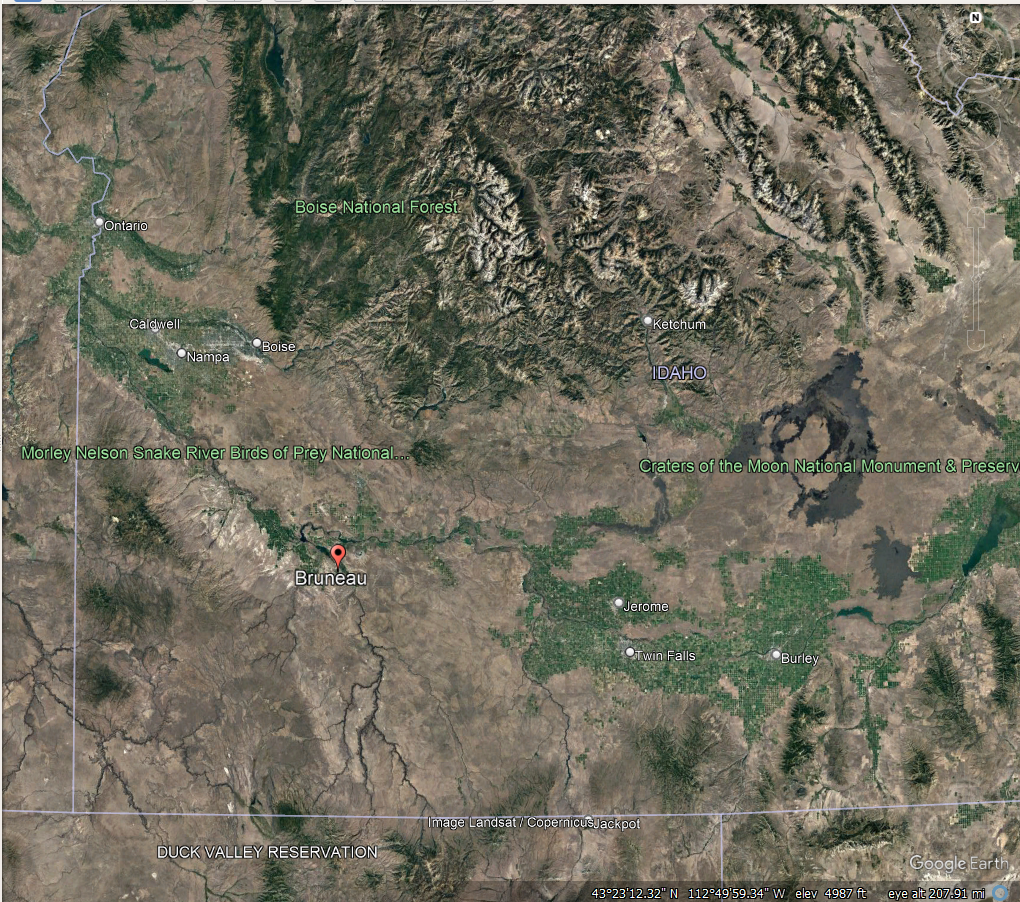  [img src=" 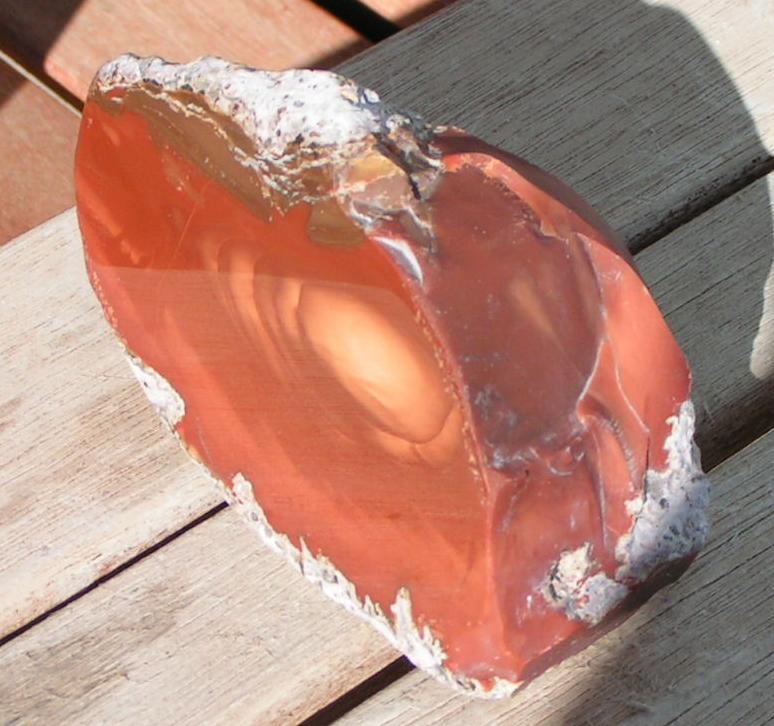 " alt="4"] 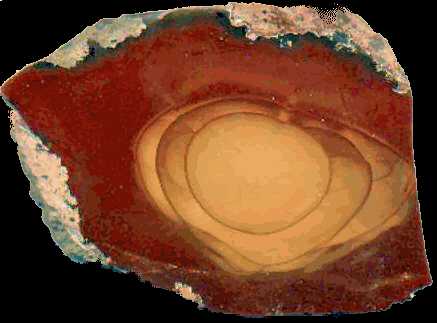 |
|
khara
fully equipped rock polisher
  
Member since September 2022
Posts: 1,979
|
Post by khara on Nov 11, 2023 17:33:47 GMT -5
Ahh! I get it now, you didn’t want to cover the back. Completely makes sense with this quality material! This cab isn’t ruined! I would set this in a silver setting with a bezel. I would cut the backing plate mostly out after soldering on my bezel. This way the sides, where you can see the transition from optical quartz to Bruneau are completely covered while both the front and back show. A complete bezel *may* be achievable via a wire wrap but that may be tough in some areas especially up at the bail. Some expert wrappers here could better say. But, like you said, good learning experience. I personally prefer the prize stone to be on top as opposed to optical quartz, so I don’t think this is a bad cab, I just think it now needs to be set to hide the sides.👍👍
|
|
khara
fully equipped rock polisher
  
Member since September 2022
Posts: 1,979
|
Post by khara on Nov 11, 2023 17:35:38 GMT -5
Very cool 1dave I’m not sure I knew Bruneau was a Thunderegg. Or if I did at one point, I’d forgotten. I’ve seen some fairly large slabs of this, with no matrix, so those eggs must’ve been able to get pretty good sized. That’s a cool pic of the complete egg slice.👍 |
|
|
|
Post by hummingbirdstones on Nov 13, 2023 0:30:46 GMT -5
Very nice cabs! I have to ask why you used optical quartz on the back of the Bruneau? Seems like kind of a waste since it's the back and Bruneau is opaque. What if I dome the back, the quartz, would that make it more of an attractive pendant piece? Your cab is fine the way it is. You did use the best pattern for the top of the cab. You can set that cab in a bezel setting and it would be just fine. khara described the way to set the stone in a way to allow the back to show. The other option is to do a step bezel, which is a little trickier. Basically, you solder a wire around the bottom of the bezel to allow the stone to be seated in the bezel. They used to make stepped bezel wire, but I haven't seen it in a real long time. |
|
dshanpnw
fully equipped rock polisher
  
Member since December 2020
Posts: 1,158
|
Post by dshanpnw on Nov 14, 2023 13:47:17 GMT -5
|
|
|
|
Post by jasoninsd on Nov 15, 2023 9:28:43 GMT -5
Hello, I'm going to continue with my doublet theme for just a bit. Here is a doublet I just finished yesterday made from clear mossy chalcedony and Death Valley Indian Paint rhyolite. The DVIP was thin so I said why not back it with the clear moss agate which was about 7mm thick. So what I really came up with instead is a moss agate backed with Death Valley Indian Paint stone. It worked out great for the agate, but not too sure about the DVIP. Is this a new idea, or happy accident, to put a nice cab on the back of another cab or has it been done before? I'm sure I'm not the first, but it wouldn't surprise me. I thought I would try to make a cab using a slab that is about 1/8" thick to see if I can do it. The reason it is important for me to know is because I have a lot of 1/8" slabs. I'd hate to not be able to use them. This cab is kind of thin for me, but I think it turned out okay. It can be done! Lookin' good on the doublets Doug!  If you do a search on here for doublets (I warn you...it can take you down some rabbit holes! LOL), you'll probably see people have combined all sorts of material for doublets...including mirrors! LOL I'm stoked you figured out you can cab a 1/8" piece of material. I've been exactly where you are...and I remember how stoked I was when I realized I could cab something that thin! Congrats on that for sure!  |
|
dshanpnw
fully equipped rock polisher
  
Member since December 2020
Posts: 1,158
|
Post by dshanpnw on Jan 4, 2024 12:34:54 GMT -5
I am still fooling around with the triplet and doublet idea. Here I have for you a triplet. The cap is optical quartz and the back is plain window glass, lots of chipping around the edges. As for the stone, I don't know. I thought it was a flame agate or moss agate, but no idea where it is from. The reason for making this a triplet was the slab was thin, 3/16". I hope you'll like it. Thanks. before Top  Side 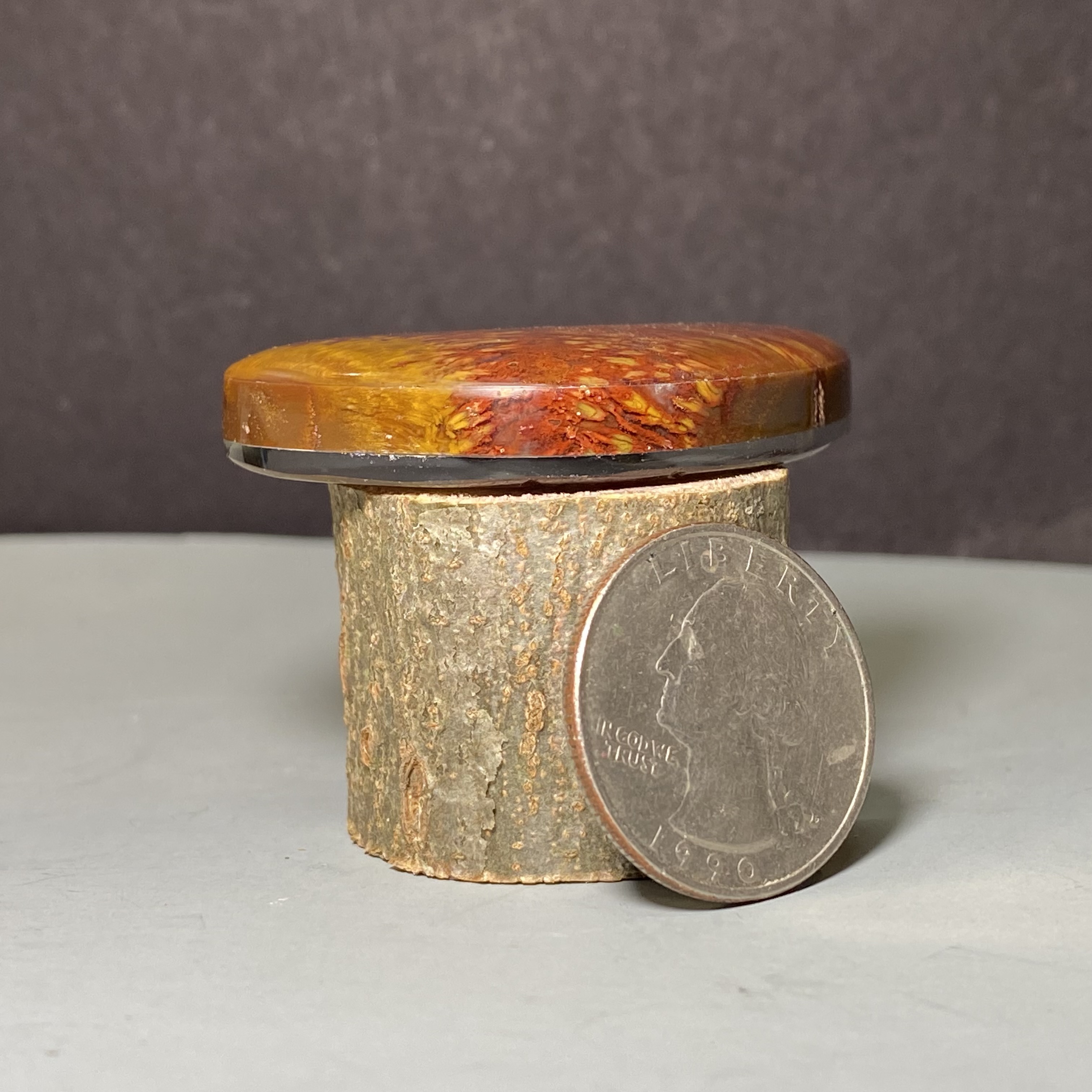 Back 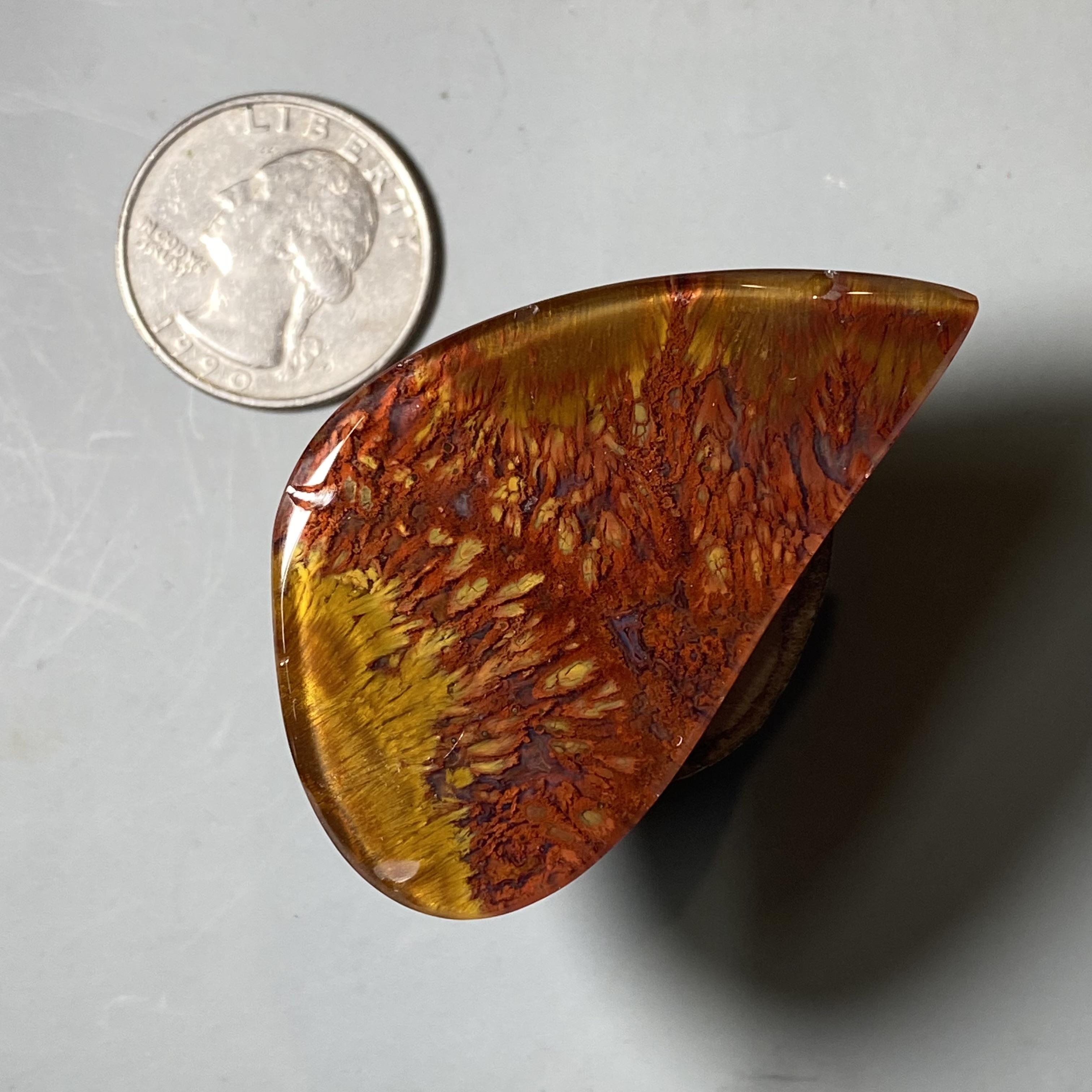 |
|
realrockhound
Cave Dweller  Chucking leaverite at tweekers
Chucking leaverite at tweekers
Member since June 2020
Posts: 4,495
Member is Online
|
Post by realrockhound on Jan 4, 2024 12:55:28 GMT -5
Bloody basin?
Also… I didn’t realize this was an old thread at first and was like it’s Friday? My days are so off
|
|
dshanpnw
fully equipped rock polisher
  
Member since December 2020
Posts: 1,158
|
Post by dshanpnw on Jan 4, 2024 13:42:38 GMT -5
Bloody basin? Also… I didn’t realize this was an old thread at first and was like it’s Friday? My days are so off I don't know the best way to add a post to already existing thread. Thank you for the ID. |
|
realrockhound
Cave Dweller  Chucking leaverite at tweekers
Chucking leaverite at tweekers
Member since June 2020
Posts: 4,495
Member is Online
|
Post by realrockhound on Jan 4, 2024 14:49:05 GMT -5
Bloody basin? Also… I didn’t realize this was an old thread at first and was like it’s Friday? My days are so off I don't know the best way to add a post to already existing thread. Thank you for the ID. I'm very  that I have some Bloody Basin Plume agate. colors look right, plumes look right from nicer material I’ve seen (which yours is the nicer variety). |
|
|
|
Post by jasoninsd on Jan 5, 2024 22:49:23 GMT -5
dshanpnw - That's a great way to use the optical quartz!! Love the looks of that one! Way to go!! 
|
|
|
|
Post by hummingbirdstones on Jan 5, 2024 23:02:25 GMT -5
That's a beautiful cab! Great job on it.  |
|